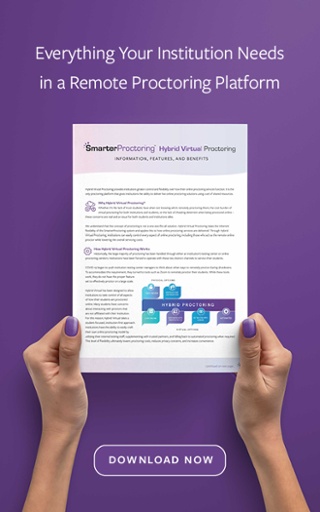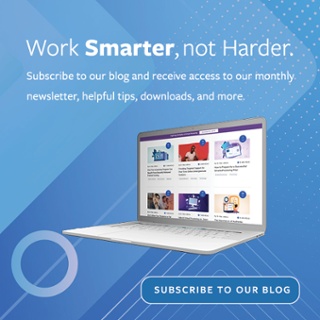
We have good news for testing centers. Check out this video and blog summary below to learn how your testing center can increase its revenue by using Hybrid Virtual Proctoring.
Video Overview:
A Silver Lining from the Pandemic: Hybrid Virtual Proctoring
Due to the pandemic, testing centers had to remain closed for weeks and in some cases months. During this period of time, the employees of the testing centers could not perform their work duties of face-to-face proctoring.
So, a few testing centers including Florida State College at Jacksonville, Louisiana State University, and San Juan College reached out to SmarterProctoring to see if there was a way that we could help. Through a collaborative effort with these and other schools, a new proctoring modality emerged called Hybrid Virtual Proctoring. Using Hybrid Virtual Proctoring, the testing center employees could be the persons who are monitoring the test takers during a virtual proctoring session. Some have referred to this as a “bring your own proctor” model of virtual proctoring.
Using Hybrid Virtual Proctoring an employee of the institution, which could be a testing center staff member, faculty member, eLearning staff member, or graduate assistant, is able to monitor a student who is testing virtually. They can monitor up to ten students at a time and are able to communicate with the student via text or voice chat. They are assisted by the artificial intelligence (AI) of the SmarterProctoring platform which is constantly scanning for testing anomalies.

5 Benefits of Hybrid Virtual Proctoring to Testing Centers
As we are now working with several schools as they are using Hybrid Virtual Proctoring, the following five benefits to the testing center have emerged: they can make money, expand services, control quality, demonstrate expertise, and be prepared. Let’s look at each of these a bit more closely.
#1: Making Money
As an impact of the pandemic, the amount of revenue generated by testing centers has declined and has not recovered in many instances. Testing centers may welcome the opportunity to use their existing staff and resources to generate more revenue.
The cost to the school for a Hybrid Virtual Proctoring session is the same as a fully automated testing session. Some testing centers have recognized that they can then add a few dollars to the fee the student pays to generate additional revenue.
For example, suppose a testing center provides face-to-face testing to students in the testing center at no charge as a service of the institution. But when a student prefers the convenience of testing remotely, they could be charged a fee. The cost of a Hybrid Virtual Proctoring session varies depending on volume. But suppose that cost is $3.95 per session (this is a high volume price point). The testing center could charge the student $9.95 per session thus generating $6.00 per session for the testing center. This cost to the student is still substantially less than the fees typically paid for live, virtual proctoring services provided by a proctoring company.
#2: Expanding Services
Most testing centers would state their mission as something like, “To foster academic integrity through exam monitoring.” However, they have been limited in fulfilling that mission by the physical constraints of the testing center. They can only test as many students as they have seats in their location.
But using Hybrid Virtual Proctoring, testing centers are able to expand the services that accomplish their mission by providing virtual proctoring services to their students. Many testing centers are frustrated by their small physical locations. Using Hybrid Virtual Proctoring allows them to expand their services beyond face-to-face testing to include live, virtual proctoring as well.
#3: Controlling Quality
A concern often expressed by schools regarding live virtual proctoring is quality control of the proctoring. It is not uncommon for a faculty member to review a virtual testing session and spot a testing anomaly that was missed by the third-party proctoring company. Well, as the maxim states, “If you want something done right, do it yourself!”
Hybrid Virtual Proctoring allows schools to have the ability to control their quality by equipping their own personnel to serve as virtual proctors.
#4: Demonstrating Expertise
Collegiate testing centers should be recognized as the testing experts on campus. They have vast experience and expertise in providing testing services. They are also equipped with the knowledge and tools needed to provide services for learners with disabilities, both physical and emotional.
Yet when virtual proctoring was outsourced to third-party companies, this left some testing centers feeling that their expertise was not recognized nor valued. Hybrid Virtual Proctoring provides testing centers with another tool that they can use to establish themselves as the testing authorities for the institution.
#5: Being Prepared
The pandemic has forced all institutions to revisit their academic continuity plan. Hopefully, there will not be another crisis on the global scale of the pandemic that forced the closure of schools worldwide.
But what is much more likely is that regional or local events can force campus closure and the transition of services online. This could include natural phenomena such as hurricanes, tornadoes, or fires. It could also include local crises such as an active shooter or bomb threat. When any event forces the closure of a testing center for any period of time, when they are equipped with Hybrid Virtual Proctoring, they can quickly pivot so that their staff can continue to provide exam monitoring services even when away from campus.

Continue Learning and Reach Out
If you would like to see a demonstration of Hybrid Virtual Proctoring so that you can visualize how it could benefit your institution, please reach out to us and we'd be happy to help.

.jpg)


